Chapter 1: Introduction
Chapter 2: Annual catches and overview
Chapter 3: Actual fishing method
Chapter 4: Attention to equipment
Chapter 5: The ecology of Kokanee in my home lake (Lake Numazawa, Fukushima Prefecture)
Chapter 6: Enjoying Kokanee
Chapter 7: Conclusion
Since Lake Numazawa has been closed to fishing from last year to this year, I can no longer go kokanee fishing. Therefore, I’ve decided to compile my fishing methods to date.
I primarily use a fishing method involving a kayak and Garmin sonar. I will organize this information into chapters, with the ultimate goal of publishing it as a PDF book.
Chapter 1: Introduction
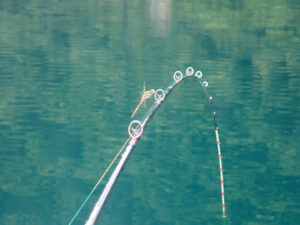
First, I’d like to briefly explain the journey that led to the fishing methods introduced in this book.
I started kokanee fishing using a kayak in 2018. Initially, I struggled to achieve good results and spent many days of trial and error. However, by 2023, I finally arrived at a stable and effective method.
Below, I will describe the process that led to this method, divided into three stages.
Section 1: The Era of Chumming Sabiki Fishing and Standard Fish Finders (2018)

Equipment Used:
Kayak: Fujita canoe Alpinia 2 (two-person folding)
Fish Finder and Transducer:
Early: HONDEX 611CN (for pond smelt) + TD08, Garmin GISMAP 64
Later: Garmin Echomap Plus 95sv + GT52
Rods and Reels:
Shimano Bioimpact X Karei x 2, Calcutta Conquest F300 (PE #2) x 2
Rig:
Hayabusa Willy 5-go (leader 0.8-go, 8 hooks), Fujiwara TG Skully 30-go, chumming basket
Overview of Fishing Method:
This style involved putting chum for sea bream into a chumming basket and waiting for schools of fish, trying to stay in the same location as much as possible using GPS. On windy days, the kayak tended to drift, so I tried to trace the same course.
Results and Challenges:
Since it was essentially a “waiting for schools” type of fishing, there were often long periods without catches, requiring a lot of patience. The introduction of the Garmin fish finder halfway through allowed for a clearer understanding of the schools, but it could still only detect “schools passing below,” limiting strategic proactivity.
Section 2: The Era of Sabiki Fishing with Forward and Down-Scanning Sonar (2019-2021)

Equipment Used:
Kayak: Fujitakanoe Alpinia 2 (two-person folding)
Fish Finder and Transducer:
Forward Scan: Garmin Echomap Plus 95sv + PS31
Down Scan: Garmin Echomap Plus 73cv + PS22
Rods and Reels:
Shimano Bioimpact X Karei x 2
Shimano Aldebaran Ag7 (PE #2) x 2 (changed to 1 later)
Rig:
Hayabusa Willy 5-go (leader 0.8-go, 8 hooks), Daiwa Tungsten Sinker 30-go
Overview of Fishing Method:
I adopted a method where I would use the forward-scanning sonar to detect schools up to about 60m ahead. After approaching a school, I would use down-scanning sonar to confirm its exact position before dropping the rig. This allowed me to explore the entire lake, shifting from the traditional “waiting for schools” to an “active fishing method” where I actively pursued them.
Results and Challenges:
Catches improved dramatically, with some days reaching the lake’s catch limit of 50 fish.
However, moving with transducers mounted on both sides of a hand-paddled kayak was physically demanding. Also, since the transducers were at the front of the kayak, it was sometimes difficult to grasp the relationship between where the rig was dropped and the fish’s location.
While this “finding schools and accurately dropping the rig” style was established, further efficiency was sought, leading to another upgrade in equipment and tactics in 2022.
Section 3: The Era of Forward Sonar and Pedal Kayaks (2022-)
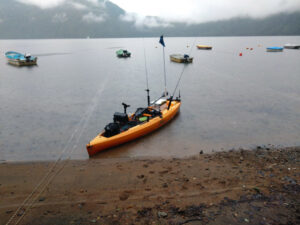
Equipment Used:
Kayak: Hobie Kayak Compass (pedal-powered)
Fish Finder and Transducer:
Garmin Echomap Plus 95sv + PS31 (forward-scanning)
Rods and Reels:
Daiwa Analyster Light Game 64 S-190・Y + Shimano Aldebaran BFS
Rig:
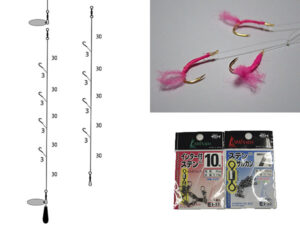
Homemade leader 1-go, 4 hooks, 2-linked (with attractor plate) + Daiwa Tungsten Sinker 30-go
Overview of Fishing Method:
While the method for detecting schools remained the same as the previous stage, the introduction of a pedal-powered kayak allowed for much faster approach to schools. Furthermore, by ingeniously mounting the forward-scanning sonar at the rear of the kayak, the visibility of fish schools in the direction of travel and the drop point of the rig significantly improved.
Regarding the rig, since pre-made products were no longer available, I started making my own. The style changed to using two linked 4-hook rigs with attractor plates. Additionally, a softer 6:4 taper rod was chosen to handle the strong pull of kokanee.
Results and Challenges:

In the first year of introducing the pedal kayak, I focused too much on pedal operation, resulting in many instances of overshooting schools or missing the timing for dropping the rig, which negatively impacted catches.
From the second year onwards, I committed to using the pedal drive solely as a means of approaching schools, and then continuing to make fine adjustments by hand-paddling near the schools. This improved timing accuracy and led to stable catches.
Below is the planned table of contents. Each chapter will be uploaded sequentially as it’s completed.
Chapter 1: Introduction
Chapter 2: Annual catches and overview
Chapter 3: Actual fishing method
Chapter 4: Attention to equipment
Chapter 5: The ecology of Kokanee in my home lake (Lake Numazawa, Fukushima Prefecture)
Chapter 6: Enjoying Kokanee
Chapter 7: Conclusion


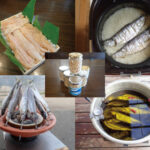
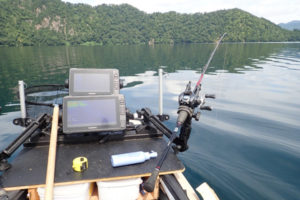
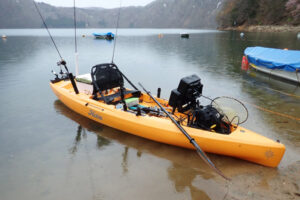
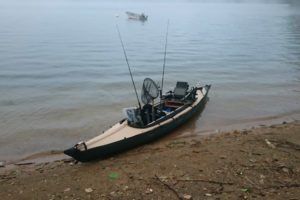
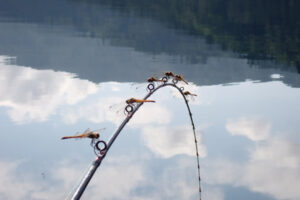
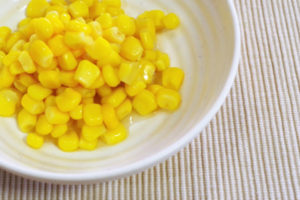
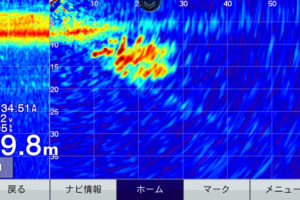

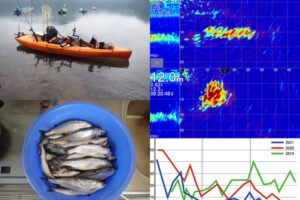
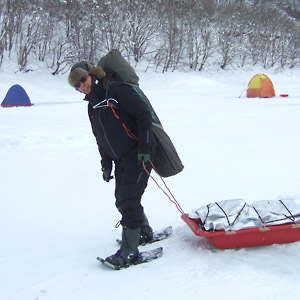
コメントを残す